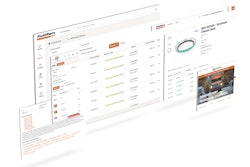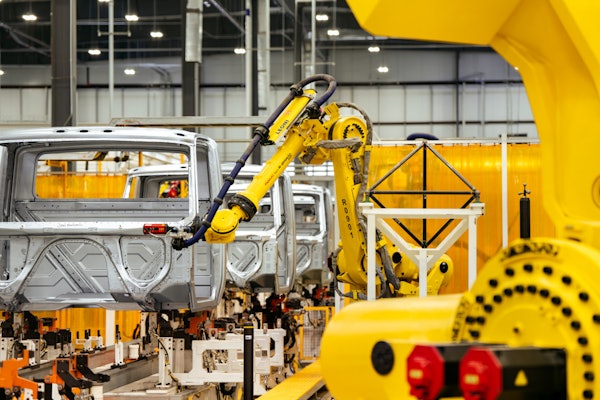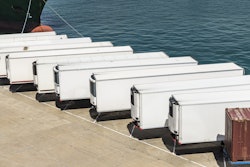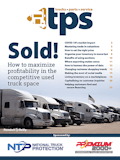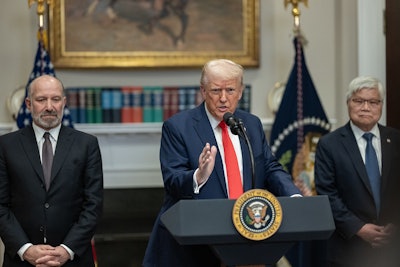
FTR is not only dating their slides on President Donald J. Trump’s tariff policy, they’re also time-stamping them.
“Every day and every hour can be a seismic shift,” says Jonathan Starks, CEO. The rampant uncertainty is “a disastrous way to conduct policy,” he continued, and it’s creating significant downside pressure.
“This is a big frigging deal,” he says, kicking off what was supposed to be a monthly webinar on intermodal forecasts. With days to go, the company pivoted to address the uncertainty roiling U.S. markets. “This is a trade war, in effect.”
 FTR Intelligence
FTR Intelligence
Where things stand
On Feb. 4, 25% tariffs were supposed to take effect on Mexico and Canada, with an additional 10% tariff on Chinese imports. All but the Chinese tariffs were paused, then threatened again and actually enacted for a short time earlier this month. That also included a 10% tariff on Canadian energy products and another 10% tariff on Chinese imports.
On March 6, the White House exempted automakers as covered by the United States-Mexico-Canada Agreement (USMCA), at least until April 2, when another slate of broad-based, 25% reciprocal tariffs are planned, including levies on automobiles and parts, semiconductors, pharmaceuticals and tariffs targeting the European Union.
Separately, Trump enacted 25% tariffs on steel, aluminum and fabricated metal parts started on March 12. There are no country-specific exemptions and even fewer details about what will be taxed and when.
“You’re going to have to pay very close attention in your business to know what that looks like,” says Eric Starks, chairman of FTR’s board.
[RELATED: Economists try to make sense of Trump's new tariffs]
The U.S. is also proposing fees for Chinese ships making U.S. ports of call. Chinese ocean carriers would have to pay $1 million each time a container ship enters a U.S. port. Ocean carriers operating a Chinese-built vessel would face fees from $500,000 to $1.5 million for each port call, depending on the percentage of Chinese-built vessels in the operator’s fleet.
In addition, retaliatory tariffs from other countries and export controls to counter U.S. measures are in place. These include:
- 15% tariffs imposed by China on Feb. 10 on coal and liquified natural gas, and 10% on crude oil, agricultural machinery and large-engine vehicles.
- 15% tariffs imposed by China on March 4 on chicken, wheat, corn and cotton and a 10% tariff on agricultural products.
- Export controls on five rare earth minerals. FTR says about 40% of U.S. imports of rare earth minerals come from China.
- 25% tariffs on U.S. imports to Canada, which are delayed because of the U.S. pause, but another 25% tariff was imposed on goods because of the aluminum and steel tariffs enacted by the U.S. on March 12.
- The European Union says it will impose tariffs in response to steel and aluminum tariffs imposed by the U.S. Those tariffs will be on goods such as motorcycles and bourbon, with more broad measures promised by mid-April. In a tit-for-tat, Trump threatened a 200% tariff on alcoholic beverages coming from Europe.
Jonathan Starks says the reality is the tariffs, threatened and otherwise, and shifting justifications and timelines for those tariffs, are affecting businesses. Without certainty, business can’t plan and without a plan, businesses can’t invest and grow, the FTR panel says.
In an interview on Fox News on Sunday, the president appeared to brush off any calls for clarity on tariffs.
“They always say that. ‘We want clarity,’” he says. “They have plenty of clarity. … The tariffs could go up as time goes by, and they may go up, and you know, I don’t know if it’s predictability.”
[RELATED: TPS readers weigh in on Trump tariffs]
Stock markets are responding to the threats and levies with a selloff. Thursday, both the Dow and S&P 500 are on track to hit 2025 lows and the Nasdaq fell more than 300 points.
“I’m not going to bend at all,” Trump said Thursday during a meeting in the Oval Office. “We’ve been ripped off for years, and we’re not going to be ripped off anymore.”
The National Association of Manufacturers recently released a first-quarter survey that highlighted manufacturers’ concern over uncertainties. For the quarter, trade uncertainty topped the list of concerns, cited by 76.2% of respondents. That’s a 20% jump from the fourth quarter of 2024 and a 40% jump from the third quarter.
The survey also showed manufacturers expect raw material prices and other input costs to rise 5.5%, which is the highest anticipated rate of increase since 2022, when inflation was between 8-9%. They also expect prices on their own product lines to increase 3.6% and expect sluggish export sales.
“This feels similar, in a lot of ways, to 2008-09,” Eric Starks says. “The difference is that was something in the broader economy that’s starting to collapse. This is being collapsed by one individual.”
 FTR Intelligence
FTR Intelligence
Steel and aluminum
The U.S. imports 41.4% of its aluminum from Canada.
“That’s a big deal,” Eric Starks says, adding a threatened 50% tariff would have decimated the aluminum market and a 25% tariff is still going to cause pain. And, assuming a 25% tariff on just aluminum and steel, FTR says prices of trucks and trailers are going to go up.
Senior analyst Dan Moyer says Class 8 trucks will see an estimated increase of 4-6%. Medium-duty trucks will see a slightly smaller 4-5% increase. Dry and refrigerated trailers will see 6-8% price hikes and other heavy-duty trailers an 8-10% jump in cost.
MEMA, the Vehicle Suppliers Association, says it supports efforts to strengthen domestic manufacturing, but the changes to steel and aluminum tariffs will cause cost pressures and supply chain challenges that will impact the industry’s competitiveness.
“MEMA is concerned that ending supply agreements with allied nations and the immediate sunset of the exclusion process will hinder the industry’s ability to secure essential materials,” it says in a release.
The group says a recent survey shows the vast majority (78%) of its supplier respondents are exposed to steel tariffs and 63% are exposed to aluminum tariffs. More than 80% of suppliers are exposed to steel and aluminum derivative tariffs, with more than a third seeing tariffs on the materials they import for local production and the products they deliver.
Nearly all of the supplier respondents, 97%, reported concern and increased distress among sub-tier suppliers due to announced tariffs.
“As an industry, we recognize the importance of strong domestic supply chains,” says MEMA President and CEO Bill Long. “At the same time, it is essential that trade policies allow suppliers to remain competitive in a global market. We continue to engage with policymakers to ensure these considerations are part of the broader discussion on economic growth and job creation.”
Moyer says about half of the Class 8 trucks built in the U.S. and Canada have some exposure to tariffs, and orders this year tell the tale.
“This is the canary in the coal mine,” Moyer says.
Year-over-year, 2025 Class 8 net orders are down 26%. It’s too late to order a truck and avoid any tariff, Moyer says, but some fleets may be able to do so by shopping available Class 8 retail inventory. However, retail demand is also softening.
“Fleets are hitting the pause button on making purchases or making orders,” Moyer says. “I’m a little nervous.”
Business investment and reshoring
Jonathan Starks says one of the goals of the tariffs, bringing manufacturing back to the U.S., is admirable, but the uncertainty surrounding the administration’s policies isn’t conducive to bringing those jobs back. He sees three possible outcomes to the Trump tariffs:
- Jonathan Starks calls this one the holy grail, drastically improved domestic output. He calls it that because “I just don’t think it exists.” If the administration wanted to entice reshoring, he says, it would focus on areas where the U.S. has market advantages and capacity. “The administration is doing nothing in that regard.”
- The second outcome is some, but not a lot, of reshoring as companies naturally shift to the lowest-cost environment.
- The worst and most likely case, Jonathan Starks says, is that everything freezes. No one knows what to plan for, investments stay on the sidelines, costs go up and consumers pay the price.
“With tariffs driving uncertainty, U.S. manufacturers are racing to secure materials, while Canadian and Mexican suppliers are feeling the squeeze from weaker export demand,” says Krish Vengat, vice president of consulting at GEP, who maintains a global supply chain volatility index. “Companies must remain agile — diversifying supply sources and optimizing inventory strategies to navigate this ongoing volatility.”
Environmental regulations
Also on March 12, the Trump administration announced it was reconsidering a wave of environmental regulations, including the Phase 3 greenhouse gas rules and NOx regulations.
Normally, Vice President of Trucking Avery Vise says, the NOx rules would be allowed to take effect given the investment the industry has made.
“We’re not in an environment where we’re following normal practice,” Vise says. While it may initially look positive for the industry, the rollback of the NOx rule, specifically, just introduces more uncertainty, he says. There are few details on how the rule will be undone and when. Courts may or may not intervene. Fleets may assume it’s not going to be enforced and nix plans for any pre-buy.
“It adds a whole lot more uncertainty into the market for the next year or so,” he says.




